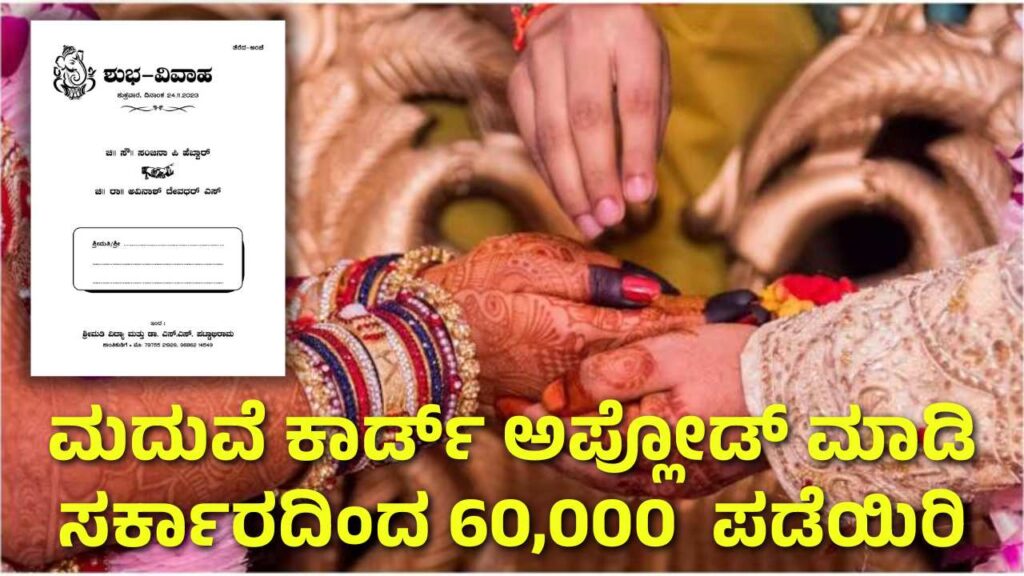The Karnataka government has implemented several marriage assistance schemes over the years to support economically disadvantaged communities. These initiatives aim to alleviate the financial burden associated with weddings, particularly for minority groups and low-income families. This article provides an overview of the key schemes, their objectives, eligibility criteria, benefits, and the political and financial challenges they have faced.(The Hindu)

1. Shaadi Bhagya (Bidaai) Scheme
Overview
Launched in 2013 under the Congress-led government headed by Chief Minister Siddaramaiah, the Shaadi Bhagya scheme, also known as the Bidaai scheme, was designed to provide financial assistance to women from economically backward minority communities for marriage expenses. The scheme targeted communities including Muslims, Christians, Jains, Buddhists, Sikhs, and Parsis.(Maps of India, The Hindu)
Objectives
- To offer financial support of ₹50,000 to eligible women from minority communities to assist with marriage-related expenses.
- To promote social welfare and support for economically disadvantaged groups.(IndiaFilings)
Eligibility Criteria
- The beneficiary must be a resident of Karnataka for at least three years.
- The applicant should belong to a Below Poverty Line (BPL) family.
- The annual family income should be less than ₹1.5 lakh.
- The bride must be at least 18 years old, and the groom must be at least 21 years old at the time of marriage.
- Widows and divorcees intending to remarry were also eligible.(IndiaFilings)
Application Process
Applicants were required to submit necessary documents, including income and caste certificates, age proof, and marriage invitations, along with a court fee stamp of ₹100. The application had to be submitted to the Minority Welfare Department offices in Karnataka. After the marriage, additional documents like the marriage certificate and joint photographs were needed to process the financial assistance.(IndiaFilings)
Challenges and Discontinuation
Despite its noble intentions, the Shaadi Bhagya scheme faced several challenges:(The Hindu)
- Funding Issues: By 2019, the scheme had over 28,000 pending applications, with dues amounting to approximately ₹142.7 crore, far exceeding the allocated budget.
- Political Controversy: The scheme was criticized for being exclusive to minority communities, leading to demands for its extension to all economically disadvantaged groups.
- Discontinuation: In the 2020-21 budget, the BJP-led government under Chief Minister B.S. Yediyurappa did not allocate funds for the scheme, effectively discontinuing it. (The Hindu, The Hindu, The Federal)
2. Saptapadi (Mangalya Bhagya) Scheme
Overview
Introduced in 2020 by the BJP government, the Saptapadi scheme aimed to promote mass marriages across Karnataka. The initiative was later renamed Mangalya Bhagya under the Congress government. The scheme was managed by the Endowments Ministry and conducted mass marriages at select temples.(The Times of India, The New Indian Express)
Objectives
- To reduce the financial burden of marriage on poor families.
- To discourage extravagant wedding expenses.
- To promote simplicity and communal harmony through mass marriages.(The Hindu, The Times of India, Maps of India)
Benefits
- Each couple received wedding attire (a silk saree for the bride and a dhoti for the groom).
- The bride received ₹1,000, and the groom received ₹5,000 in cash.
- An 8-gram gold mangalsutra was provided to the bride.
- The total expenditure per couple was approximately ₹55,000. (The New Indian Express, The Times of India)
Challenges
The scheme faced implementation challenges due to:(The New Indian Express)
- Budget Constraints: The government’s focus on other welfare schemes and rising gold prices impacted the allocation of funds for mass marriages.
- Pandemic Impact: The COVID-19 pandemic led to the postponement of planned mass marriage events in 2020.(The New Indian Express)
3. Karnataka Building and Other Construction Workers Welfare Board (KBOCWWB) Marriage Assistance Scheme
Overview
This scheme, under the Department of Labour, provides financial assistance to registered construction workers for their own marriages or the marriages of their dependent children.(Government schemes)
Objectives
- To support construction workers in managing marriage expenses.
- To promote the welfare of workers in the unorganized sector.(Government schemes)
Eligibility Criteria
- The applicant must be a registered construction worker with at least one year of membership with the KBOCWWB.
- The benefit is applicable only for the first marriage.
- The assistance can be availed for the worker’s own marriage or for the marriages of up to two dependent children.(Government schemes)
Benefits
- A financial assistance of ₹60,000 per marriage is provided.
- The benefit can be claimed only twice per family.(Government schemes)
Application Process
Applications can be submitted online through the KBOCWWB website or offline at designated offices. The application must be submitted within six months of the marriage date. (Government schemes)
Conclusion
The Karnataka government’s marriage assistance schemes have played a significant role in supporting economically disadvantaged communities. While initiatives like Shaadi Bhagya aimed to uplift minority groups, they faced challenges related to funding and inclusivity. The Saptapadi and KBOCWWB schemes expanded the scope of assistance to a broader population, promoting communal harmony and worker welfare. However, consistent funding and inclusive policies remain crucial for the sustained success of such welfare programs.(The Hindu, The Hindu, The Times of India)
